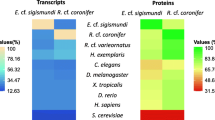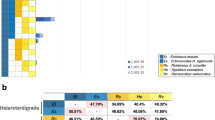Abstract
Semi-terrestrial tardigrades exhibit a remarkable tolerance to desiccation by entering a state called anhydrobiosis. In this state, they show a strong resistance against several kinds of physical extremes. Because of the probable importance of stress proteins during the phases of dehydration and rehydration, the relative abundance of transcripts coding for two α-crystallin heat-shock proteins (Mt-sHsp17.2 and Mt-sHsp19.5), as well for the heat-shock proteins Mt-sHsp10, Mt-Hsp60, Mt-Hsp70 and Mt-Hsp90, were analysed in active and anhydrobiotic tardigrades of the species Milnesium tardigradum. They were also analysed in the transitional stage (I) of dehydration, the transitional stage (II) of rehydration and in heat-shocked specimens. A variable pattern of expression was detected, with most candidates being downregulated. Gene transcripts of one Mt-hsp70 isoform in the transitional stage I and Mt-hsp90 in the anhydrobiotic stage were significantly upregulated. A high gene expression (778.6-fold) was found for the small α-crystallin heat-shock protein gene Mt-sHsp17.2 after heat shock. We discuss the limited role of the stress-gene expression in the transitional stages between the active and anhydrobiotic tardigrades and other mechanisms which allow tardigrades to survive desiccation.



Similar content being viewed by others
References
Alamillo J, Almoguera C, Bartels D, Jordano J (1995) Constitutive expression of small heat shock proteins in vegetative tissues of the resurrection plant Craterostigma plantagineum. Plant Mol Biol 29:1093–1099
Altschul SF, Gish W, Miller W, Myers EW, Lipman DJ (1990) Basic local alignment search tool. J Mol Biol 215:403–410
Bahrndorff S, Tunnacliffe A, Wise MJ, McGee B, Holmstrup M, Loeschcke V (2008) Bioinformatics and protein expression analyses implicate LEA proteins in the drought response of Collembola. J Insect Physiol 55:210–217
Baumann H (1922) Die Anabiose der Tardigraden. Zool Jahrb Abt Allg Zool Physiol Tiere 45:501–556
Bonato MCM, Silva AM, Gomes SL, Maia JCC, Juliani MH (1987) Differential expression of heat-shock proteins and spontaneous synthesis of HSP70 during the life cycle of Blastocladiella emersonii. Eur J Biochem 163:211–220
Chakrabortee S, Boschetti C, Walton LJ, Sarkar S, Rubinsztein DC, Tunnacliffe A (2007) Hydrophilic protein associated with desiccation tolerance exhibits broad protein stabilization function. PNAS 104:18073–18078
Chen S, Glazer I, Gollop N, Cash P, Argo E, Innes A, Stewart E, Davidson I, Wilson MJ (2006) Proteomic analysis of the entomopathogenic nematode Steinernema feltiae IS-6 IJs under evaporative and osmotic stresses. Mol Biochem Parasitol 145:195–204
Cherkasova V, Ayyadevara S, Egilmez N, Reis RS (2000) Diverse Caenorhabditis elegans genes that are upregulated in dauer larvae also show elevated transcript levels in long-lived, aged, or starved adults. J Mol Biol 300:433–448
Clegg JS, Jackson SA, Liang P, MacRae TH (1995) Nuclear-cytoplasmic translocations of protein p26 during aerobic-anoxic transitions in embryos of artemia franciscana. Exp Cell Res 219:1–7
Crowe LM (2002) Lessons from nature: the role of sugars in anhydrobiosis. Comp Biochem Physiol A Comp Physiol 131:505–513
Crowe JH, Carpenter JF, Crowe LM (1998) The role of vitrification in anhydrobiosis. Annu Rev Physiol 60:73–103
de Jonge HJ, Fehrmann RS, de Bont ES, Hofstra RM, Gerbens F, Kamps WA, de Vries EG, van der Zee AG, te Meerman GJ, ter Elst A (2007) Evidence based selection of housekeeping genes. PLoS ONE 2:e898
Denlinger DL, Lee RE, Yocum GD, Kukal O (1992) Role of chilling in the acquisition of cold tolerance and the capacitation to express stress proteins in diapausing pharate larvae of the gypsy moth, Lymantria dispar. Arch Insect Biochem Physiol 21:271–280
Georgopoulos C, Welch WJ (1993) Role of the major heat shock proteins as molecular chaperones. Annu Rev Cell Biol 9:601–634
Gething M-J, Sambrook J (1992) Protein folding in the cell. Nature 355:33–45
Gkouvitsas T, Kontogiannatos D, Kourti A (2008) Differential expression of two small Hsps during diapause in the corn stalk borer Sesamia nonagrioides (Lef.). J Insect Physiol 54:1503–1510
Goto SG, Kimura MT (2004) Heat-shock-responsive genes are not involved in the adult diapause of Drosophila triauraria. Gene 326:117–122
Goyal K, Walton LJ, Tunnacliffe A (2005) LEA proteins prevent protein aggregation due to water stress. Biochem J 388:151–157
Guzhova I, Krallish I, Khroustalyova G, Margulis B, Rapoport A (2008) Dehydration of yeast: changes in the intracellular content of Hsp70 family proteins. Process Biochem 43:1138–1141
Haslbeck M (2002) sHsps and their role in the chaperone network. Cell Mol Life Sci 59:1649–1657
Hayward SAL, Rinehart JP, Denlinger DL (2004) Desiccation and rehydration elicit distinct heat shock protein transcript responses in flesh fly pupae. J Exp Biol 207:963–971
Hengherr S, Brümmer F, Schill RO (2008a) Anhydrobiosis in tardigrades and its effects on longevity traits. J Zool (Lond) 275:216–220 1–5
Hengherr S, Heyer AG, Köhler H-R, Schill RO (2008b) Trehalose and anhydrobiosis in tardigrades—evidence for divergence in responses to dehydration. FEBS J 275:281–288
Hengherr S, Worland MR, Reuner A, Brümmer F, Schill RO (2009) High temperature tolerance and vitreous states in anhydrobiotic tardigrades. Physiol Biochem Zool 82(6):749–755
Horikawa DD, Sakashita T, Katagiri C, Watanabe M, Kikawada T, Nakahara Y, Hamada N, Wada S, Funayama T, Higashi S, Kobayashi Y, Okuda T, Kuwabara M (2006) Radiation tolerance in the tardigrade Milnesium tardigradum. Int J Radiat Biol 82:843–848
Horwich AL, Fenton WA, Chapman E, Farr GW (2007) Two families of chaperonin: physiology and mechanism. Annu Rev Cell Dev Biol 23:115–145
Ingram J, Bartels D (1996) The molecular basis of dehydration tolerance in plants. Annu Rev Plant Physiol Plant Mol Biol 47:377–403
Jakob U, Gaestel M, Engel K, Buchner J (1993) Small heat shock proteins are molecular chaperones. J Biol Chem 268:1517–1520
Jönsson KI, Schill RO (2007) Induction of Hsp70 by desiccation, ionising radiation and heat-shock in the eutardigrade Richtersius coronifer. Comp Biochem Physiol B Comp Biochem 146:456–460
Jönsson KI, Rabbow E, Schill RO, Harms-Ringdahl M, Rettberg P (2008) Tardigrades survive exposure to space in low Earth orbit. Curr Biol 18:R729–R731
Keilin D (1959) The Leeuwenhoek lecture. The problem of anabiosis or latent life: history and current concept. Proc R Soc Biol Sci Ser B 150:149–191
Liang P, Amons R, Clegg JS, MacRae TH (1997a) Molecular characterization of a small heat shock/alpha-crystallin protein in encysted artemia embryos. J Biol Chem 272:19051–19058
Liang P, Amons R, Macrae TH, Clegg JS (1997b) Purification, structure and in vitro molecular-chaperone activity of artemia P26, a small heat-shock α-crystallin protein. Eur J Biochem 243:225–232
Lopez-Martinez G, Benoit J, Rinehart J, Elnitsky M, Lee R, Denlinger D (2009) Dehydration, rehydration, and overhydration alter patterns of gene expression in the Antarctic midge, Belgica antarctica. J Comp Physiol B Biochem Syst Environ Physiol 179(4):481–491
MacRae TH (2003) Molecular chaperones, stress resistance and development in Artemia franciscana. Semin Cell Dev Biol 14:251–258
McClellan AJ, Xia Y, Deutschbauer AM, Davis RW, Gerstein M, Frydman J (2007) Diverse cellular functions of the Hsp90 molecular chaperone uncovered using systems approaches. Cell 131:121–135
McGee B, Schill RO, Tunnacliffe A (2005) Hydrophilic proteins in invertebrate anhydrobiosis. Annual Meeting of the Society for Integrative and Comparative Biology (SICB), San Diego, USA
Pearl LH, Prodromou C, Workman P (2008) The Hsp90 molecular chaperone: an open and shut case for treatment. Biochem J 410:439–453
Pfaffl MW, Horgan GW, Dempfle L (2002) Relative expression software tool (REST©) for group-wise comparison and statistical analysis of relative expression results in real-time PCR. Nucleic Acids Res 30:e36
Pigoń A, Węglarska B (1955) Rate of metabolism in tardigrades during active life and anabiosis. Nature 176:121–122
Ramløv H, Westh P (1992) Survival of the cryptobiotic eutardigrade Adorybiotus coronifer during cooling to −196°C: effect of cooling rate, trehalose level, and short-term acclimation. Cryobiology 29:125–130
Ramløv H, Westh P (2001) Cryptobiosis in the eutardigrade Adorybiotus (Richtersius) coronifer: tolerance to alcohols, temperature and de novo protein synthesis. Zool Anz 240:517–523
Richter K, Buchner J (2001) Hsp90: chaperoning signal transduction. J Cell Physiol 188:281–290
Rinehart JP, Li AQ, Yocum GD, Robich RM, Hayward SA, Denlinger DL (2007) Up-regulation of heat shock proteins is essential for cold survival during insect diapause. Proc Natl Acad Sci U S A 104:11130–11137
Rozen S, Skaletsky H (2000) Primer3 on the WWW for general users and for biologist programmers. Methods Mol Biol 132:365–386
Schill RO, Fritz GB (2008) Desiccation tolerance in embryonic stages of the tardigrade Milnesium tardigradum. J Zool (Lond) 276:103–107
Schill RO, Steinbrück GHB, Köhler H-R (2004) Stress gene (hsp70) sequences and quantitative expression in Milnesium tardigradum (Tardigrada) during active and cryptobiotic stages. J Exp Biol 207:1607–1613
Schill RO, McGee B, Tunnacliffe A (2005). Molecular adaptation to extreme dehydration in tardigrades: Hsp70 gene expression, and putative LEA protein induction during cryptobiosis. International Symposium on the Environmental Physiology of Ectotherms and Plants (ISEPEP), Roskilde, Denmark
Seki K, Toyoshima M (1998) Preserving tardigrades under pressure. Nature 395:853–854
Sømme L (1996) Anhydrobiosis and cold tolerance in tardigrades. Eur J Entomol 93:349–357
Tammariello SP, Rinehart JP, Denlinger DL (1999) Desiccation elicits heat shock protein transcription in the flesh fly, Sarcophaga crassipalpis, but does not enhance tolerance to high or low temperatures. J Insect Physiol 45:933–938
Tamura K, Dudley J, Nei M, Kumar S (2007) MEGA4: molecular evolutionary genetics analysis (MEGA) software version 4.0. Mol Biol Evol 24:1596–1599
von Mering C, Jensen LJ, Snel B, Hooper SD, Krupp M, Foglierini M, Jouffre N, Huynen MA, Bork P (2005) STRING: known and predicted protein–protein associations, integrated and transferred across organisms. Nucleic Acids Res 33:D433–D437
Willsie JK, Clegg JS (2002) Small heat shock protein p26 associates with nuclear lamins and HSP70 in nuclei and nuclear matrix fractions from stressed cells. J Cell Biochem 84:601–614
Wise MJ, Tunnacliffe A (2004) POPP the question: what do LEA proteins do? Trends Plant Sci 9:13–17
Yocum GD, Joplin KH, Denlinger DL (1991) Expression of heat shock proteins in response to high and low temperature extremes in diapausing pharate larvae of the gypsy moth, Lymantria dispar. Arch Insect Biochem Physiol 18:239–249
Yocum GD, Joplin KH, Denlinger DL (1998) Upregulation of a 23 kDa small heat shock protein transcript during pupal diapause in the flesh fly, Sarcophaga crassipalpis. Insect Biochem Mol Biol 28:677–682
Acknowledgements
The authors wish to thank Eva Roth for maintaining the tardigrade culture. This study is part of the project FUNCRYPTA (0313838A, 0313838B and 0313838E), funded by the German Federal Ministry of Education and Research, BMBF.
Author information
Authors and Affiliations
Corresponding author
Rights and permissions
About this article
Cite this article
Reuner, A., Hengherr, S., Mali, B. et al. Stress response in tardigrades: differential gene expression of molecular chaperones. Cell Stress and Chaperones 15, 423–430 (2010). https://doi.org/10.1007/s12192-009-0158-1
Received:
Revised:
Accepted:
Published:
Issue Date:
DOI: https://doi.org/10.1007/s12192-009-0158-1




